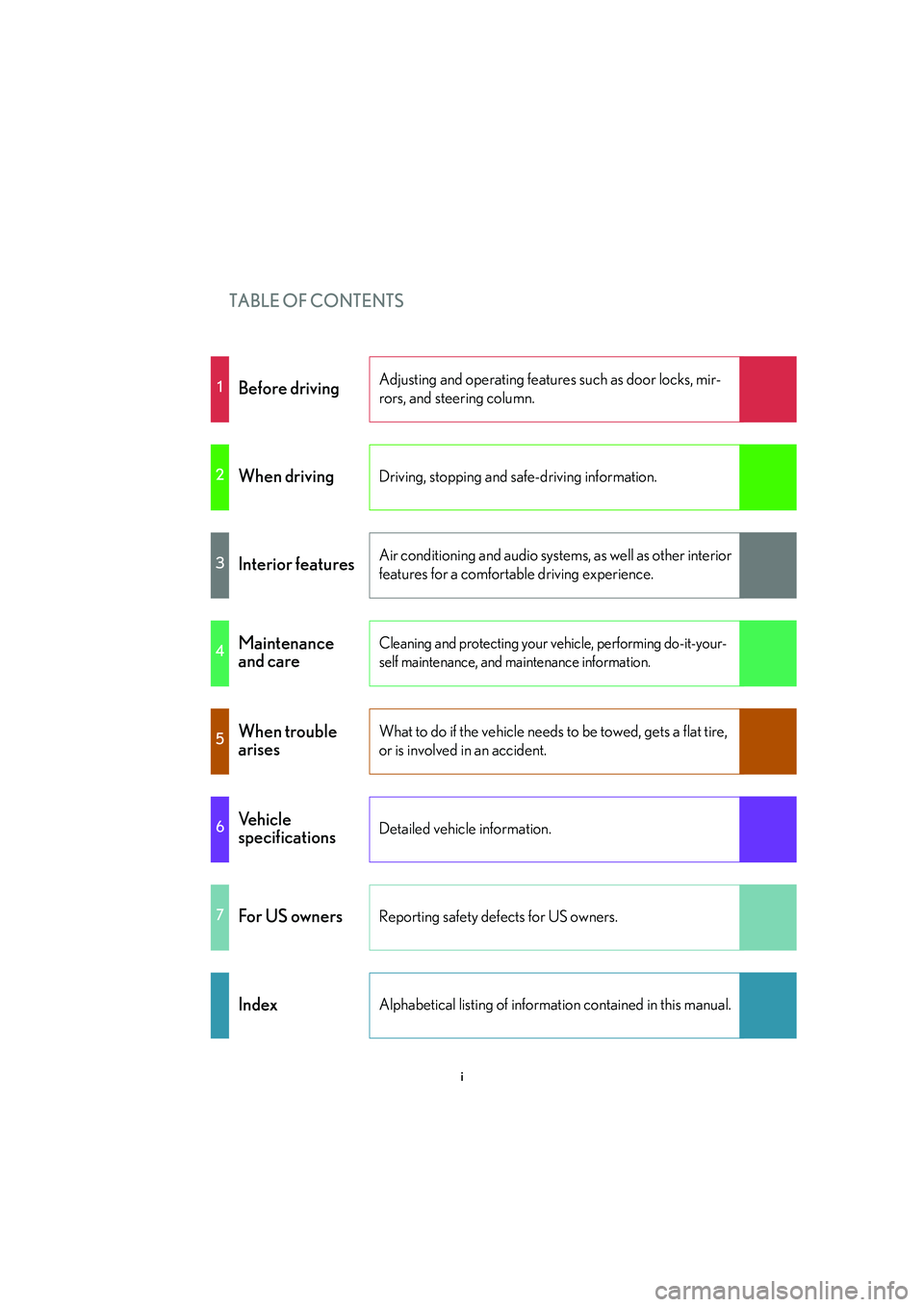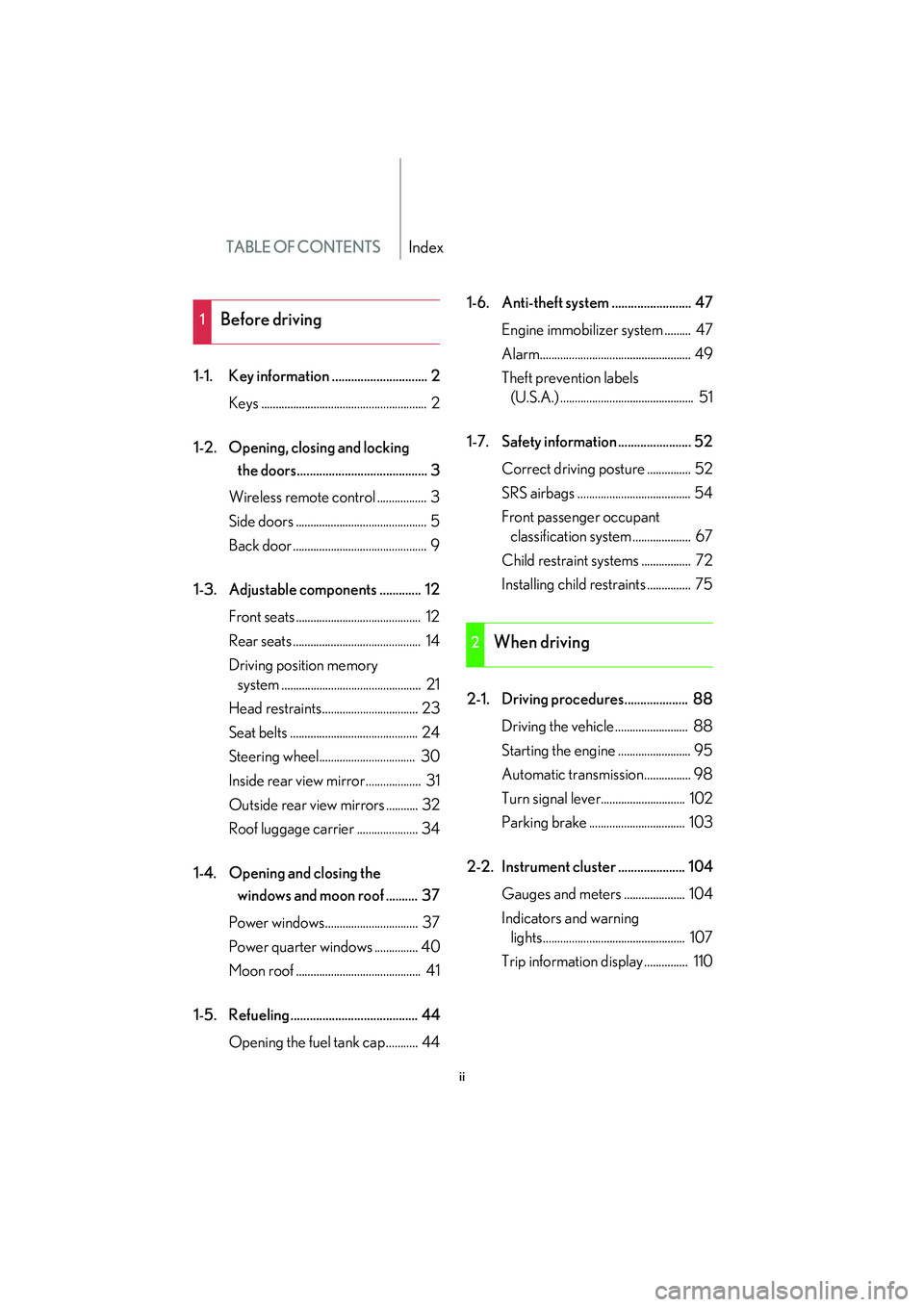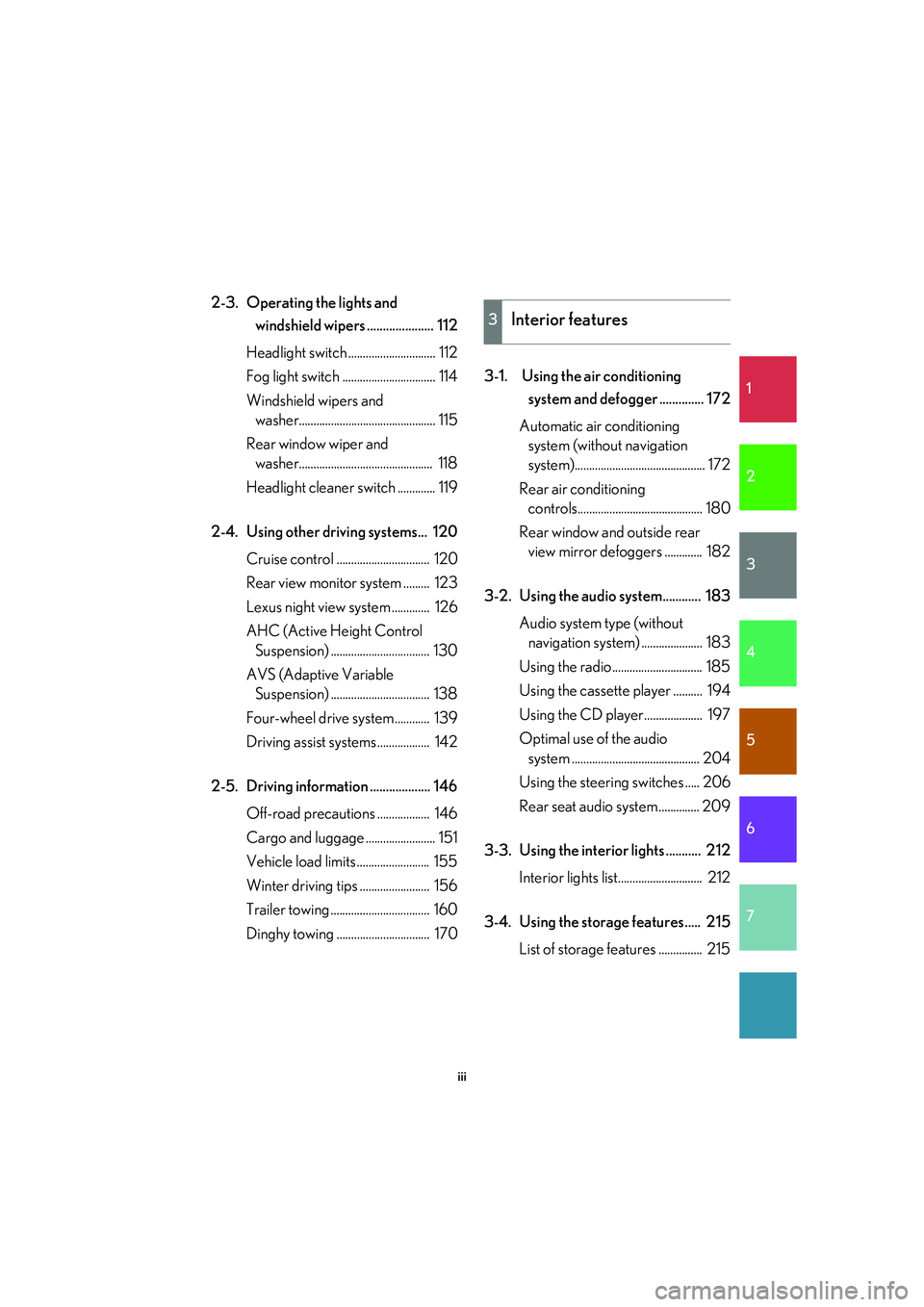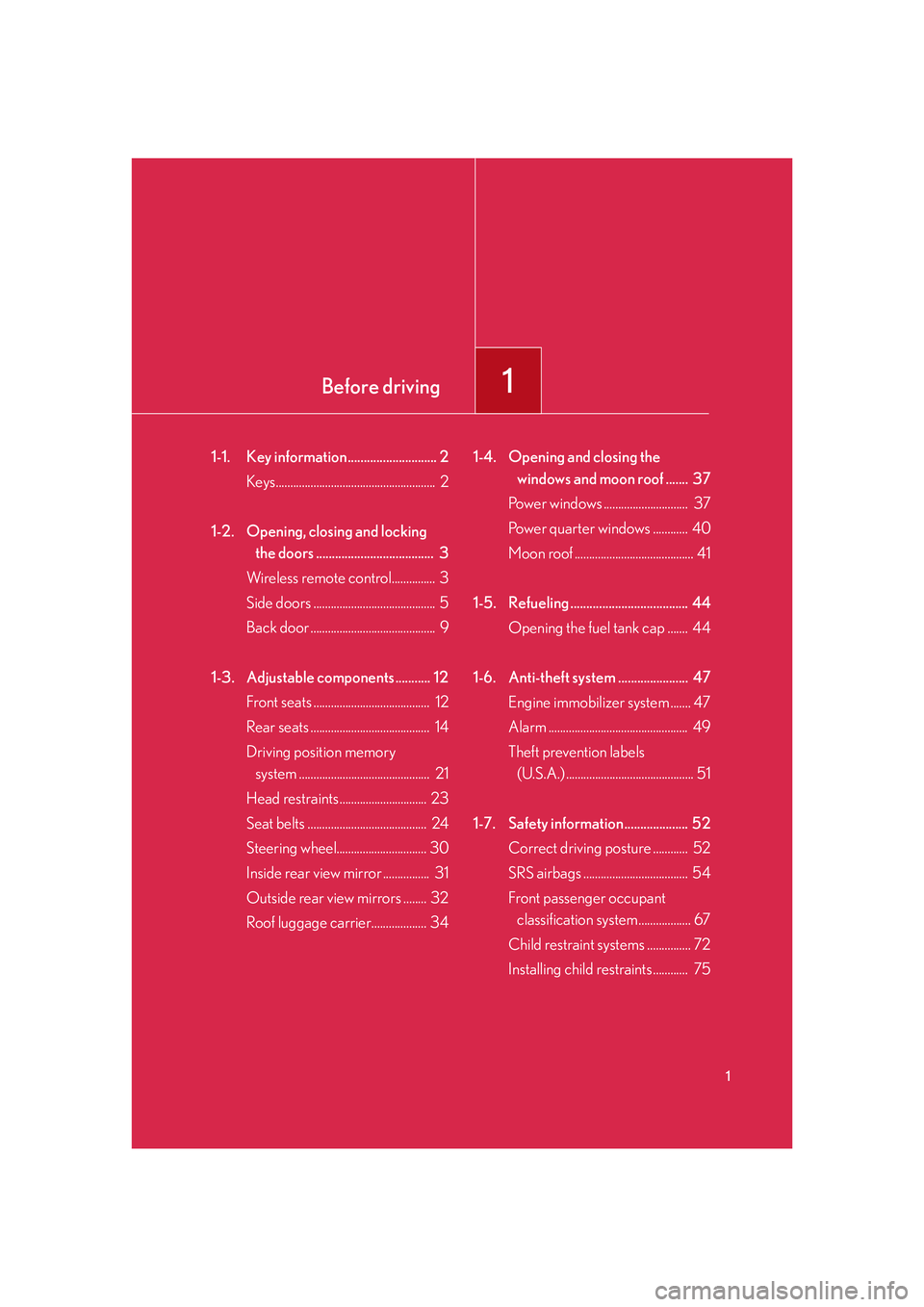steering LEXUS LX470 2007 Owners Manual
[x] Cancel search | Manufacturer: LEXUS, Model Year: 2007, Model line: LX470, Model: LEXUS LX470 2007Pages: 426, PDF Size: 10.95 MB
Page 1 of 426

TABLE OF CONTENTS
i
1Before drivingAdjusting and operating features such as door locks, mir-
rors, and steering column.
2When drivingDriving, stopping and safe-driving information.
3Interior featuresAir conditioning and audio systems, as well as other interior
features for a comfortable driving experience.
4Maintenance
and careCleaning and protecting your vehicle, performing do-it-your-
self maintenance, and maintenance information.
5When trouble
arisesWhat to do if the vehicle needs to be towed, gets a flat tire,
or is involved in an accident.
6Vehicle
specificationsDetailed vehicle information.
7For US ownersReporting safety defects for US owners.
IndexAlphabetical listing of informat ion contained in this manual.
Page 2 of 426

TABLE OF CONTENTSIndex
ii
1-1. Key information .............................. 2Keys ......................................................... 2
1-2. Opening, closing and locking the doors......................................... 3
Wireless remote control ................. 3
Side doors ............................................. 5
Back door .............................................. 9
1-3. Adjustable components ............. 12 Front seats ........................................... 12
Rear seats ............................................ 14
Driving position memory system ................................................ 21
Head restraints................................. 23
Seat belts ............................................ 24
Steering wheel................................. 30
Inside rear view mirror ................... 31
Outside rear view mirrors ........... 32
Roof luggage carrier ..................... 34
1-4. Opening and closing the windows and moon roof .......... 37
Power windows................................ 37
Power quarter windows ............... 40
Moon roof ........................................... 41
1-5. Refueling ........................................ 44 Opening the fuel tank cap ........... 44 1-6. Anti-theft system ......................... 47
Engine immobilizer system ......... 47
Alarm.................................................... 49
Theft prevention labels (U.S.A.) .............................................. 51
1-7. Safety information ....................... 52 Correct driving posture ............... 52
SRS airbags ....................................... 54
Front passenger occupant classification system .................... 67
Child restraint sy stems ................. 72
Installing child restraints ............... 75
2-1. Driving procedures.................... 88 Driving the vehicle ......................... 88
Starting the engine ......................... 95
Automatic transmission................ 98
Turn signal lever............................. 102
Parking brake ................................. 103
2-2. Instrument cluster ..................... 104 Gauges and meters ..................... 104
Indicators and warning lights................................................. 107
Trip information display ............... 110
1Before driving
2When driving
Page 3 of 426

1
2
3
4
5
6
7
iii
2-3. Operating the lights and windshield wipers ..................... 112
Headlight switch .............................. 112
Fog light switch ................................ 114
Windshield wipers and washer............................................... 115
Rear window wiper and washer.............................................. 118
Headlight cleaner switch ............. 119
2-4. Using other driving systems... 120 Cruise control ................................ 120
Rear view monitor system ......... 123
Lexus night view system ............. 126
AHC (Active Height Control Suspension) .................................. 130
AVS (Adaptive Variable Suspension) .................................. 138
Four-wheel drive system............ 139
Driving assist systems.................. 142
2-5. Driving information ................... 146 Off-road precautions .................. 146
Cargo and luggage ........................ 151
Vehicle load limits ......................... 155
Winter driving tips ........................ 156
Trailer towing .................................. 160
Dinghy towing ................................ 170 3-1. Using the air conditioning
system and defogger .............. 172
Automatic air conditioning system (without navigation
system)............................................. 172
Rear air conditioning controls........................................... 180
Rear window and outside rear view mirror defoggers ............. 182
3-2. Using the audio system............ 183 Audio system type (without navigation system) ..................... 183
Using the radio............................... 185
Using the cassette player .......... 194
Using the CD player.................... 197
Optimal use of the audio system ............................................ 204
Using the steering switches ..... 206
Rear seat audio system .............. 209
3-3. Using the interior lights ........... 212 Interior lights list............................. 212
3-4. Using the storage features..... 215 List of storage features ............... 215
3Interior features
Page 19 of 426

Before driving1
1
1-1. Key information ............................ 2Keys....................................................... 2
1-2. Opening, closing and locking the doors ..................................... 3
Wireless remote control............... 3
Side doors .......................................... 5
Back door ........................................... 9
1-3. Adjustable components ........... 12 Front seats ........................................ 12
Rear seats ......................................... 14
Driving position memory system ............................................. 21
Head restraints .............................. 23
Seat belts ......................................... 24
Steering wheel............................... 30
Inside rear view mirror ................ 31
Outside rear view mirrors ........ 32
Roof luggage carrier................... 34 1-4. Opening and closing the
windows and moon roof ....... 37
Power windows ............................. 37
Power quarter windows ............ 40
Moon roof ......................................... 41
1-5. Refueling ..................................... 44 Opening the fuel tank cap ....... 44
1-6. Anti-theft system ...................... 47 Engine immobilizer system ....... 47
Alarm ................................................ 49
Theft prevention labels (U.S.A.) ............................................ 51
1-7. Safety information.................... 52 Correct driving posture ............ 52
SRS airbags .................................... 54
Front passenger occupant classification system.................. 67
Child restraint systems ............... 72
Installing child restraints ............ 75
Page 39 of 426

21
1
1-3. Adjustable components
Before driving
Driving position memory system
Your preferred driving position (the position of the driver's seat, steering
wheel and outside rear view mirrors) can be entered into the computer's
memory and recalled with the touch of a button.
Two different driving positions can be entered into memory.
■Entering a position to memory
Check that the shift lever is set in “P”.
Turn the ignition key to the “ON” position.
Adjust the driver’s seat, steeri ng wheel, and outside rear view
mirrors to the desired positions.
While pushing the “SET” button,
push button “1” or “2” until the
signal beeps.
If the selected button has
already been preset, the previ-
ously recorded position will be
overwritten.
■Recalling the memorized position
Check that the shift lever is set in “P”.
Turn the ignition key to the “ON” position. Push button “1” or “2” to recall
the desired position.
STEP1
STEP2
STEP3STEP3
STEP1
STEP2
Page 40 of 426

22
1-3. Adjustable components
■Retained accessory power
Each memorized position (except for the steering wheel position) can be activated
within 30 seconds after the corresponding driver’s door is opened, even if the key is
removed from ignition switch.
■If any position memory button is pushed while the adjustments are being made
The operation will stop. To reactivate the sy stem, push the desired button (“1” or “2”)
again.
■If the battery is disconnected
The memorized positions must be reset be cause the computer's memory is erased
when the battery is disconnected.
CAUTION
■Seat adjustment caution
Take care during seat adjustment that the seat does not strike the rear passenger or
squeeze your body against the steering wheel.
If this happens, you can stop the movement by pressing another seat position mem-
ory button.
Page 48 of 426

30
1-3. Adjustable components
Steering wheel
Auto tilt away and auto returnWhen the ignition key is removed,
the steering wheel returns to its
stowed position by moving up and
away to enable easier driver entry
and exit.
Insert the key into the ignition
switch returns the steering wheel
to the original position.
The steering wheel can be adjusted to a comfortable position while the key
is inserted in the ignition switch.
Up
Down
Toward the driver
Away from the driver
CAUTION
■While driving
Do not adjust th e steering wheel.
Doing so may cause the driver to mishandle the vehicle and an accident, resulting in
death or serious injury.
Page 70 of 426

52
1-7. Safety information
Correct driving posture
Drive with a good posture as follows:
Sit upright and well back in
the seat.
Adjust the position of the seat
forward or backward to
ensure the pedals can be
reached and easily
depressed to the extent
required. (P. 12)
Adjust the seatback so that
the controls are easily opera-
ble.
Adjust the tilt and telescopic
positions of the steering
wheel downward so the air-
bag is facing your chest.
( P. 30)
Lock the head restraint in
place with the center of the
head restraint closest to the
top of your ears. ( P. 2 3 )
Wear the seat belt correctly.
( P. 2 4 )
Page 74 of 426

56
1-7. Safety information
In certain types of severe frontal or side impacts, the SRS airbag system
triggers the airbag inflators. A chemica l reaction in the inflators quickly
fills the airbags with non-toxic gas to he lp restrain the motion of the occu-
pants.
■If the SRS airbags deploy (inflate)
●Bruising and slight abrasion s may result from contact with a deploying (inflating)
SRS airbag.
●A loud noise and white powder will be emitted.
●Parts of the airbag module (steering wheel hub, airbag cover and inflator) as
well as the front seats, and parts of the front pillar and roof side rail, may be hot
for several minutes. The airbag itself may also be hot.
●The windshield may crack.
■Operating conditions (front airbags)
●The SRS front airbags will deploy if the severity of the frontal impact is above the
designed threshold level, comparable to an approximate 15 mph (25 km/h) col-
lision when the vehicle impacts straight into a fixed barrier that does not move
or deform.
However, this threshold velocity will be considerably higher if the vehicle strikes
an object, such as a parked vehicle or sign pole, which can move or deform on
impact, or if the vehicle is involved in an underride collision (e.g. a collision in
which the front of the vehicle “underrides”, or goes under, the bed of a truck, etc.).
●It is possible that in some collisions where the forward deceleration of the vehi-
cle is very close to the designed thresh old level, the SRS front airbags and the
seat belt pretensioners ma y not activate together.
●The SRS front passenger airbag will not activate if there is not passenger sitting
in the front passenger seat. However, the front passenger airbag may deploy if
luggage is put in the seat or the seat belt is fastened, even if the seat is unoccu-
pied.
Page 78 of 426

60
1-7. Safety information
■When to contact your Lexus dealer
In the following cases, contact your Lexus dealer as soon as possible. Do not dis-
connect the battery cables before contacting your Lexus dealer.
●Any of the SRS airbags have been inflated.
●The front of the vehicle is damaged or
deformed, or the vehicle was involved in an
accident that was not severe enough to
cause the SRS airbags to inflate.
●A portion of the doors is damaged or
deformed, or the vehicle was involved in an
accident that was not severe enough to
cause the SRS side airbags and curtain
shield airbags to inflate.
●The pad section of the steering wheel or
dashboard is scratched, cracked or other-
wise damaged.
●The surface of the seats with the side air-
bag is scratched, cracked, or otherwise
damaged.
●The portion of the front, center and rear pil-
lar garnish, or roof interior containing the
curtain shield airbags is scratched, cracked
or otherwise damaged.